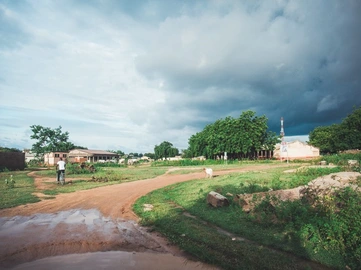How changes in climate and land use affect people's lives
April 22, 2019.
Land use and land cover changes are a result of complex human-environmental interactions, which influence the provision of ecosystem services. Many people in low-income countries, especially small-scale farmers, are highly dependent on natural resources and, therefore, rely on the provision of ecosystem services. Pressure on ecosystems due to population growth and climate change, among others, decrease this provision. Furthermore, some ecosystem services might be only seasonally available. Modeling the impact of important driving forces of land use/land cover on ecosystem services can help to determine the consequences of land use/land cover change and to identify key actions to counteract negative impacts.
This study exemplified the assessment of seasonal ecosystem services provision under changes in land use/land cover and climate in the rural agricultural system of the Upper East Region in northern Ghana. The region is characterized by small-scale and rain-fed subsistence agriculture. High population density and high poverty rates, low fertilizer input, heavily weathered soils and weather extremes contribute to land degradation and decreasing yields. A probabilistic model was developed in cooperation with scientists of the West African Science Service Center on Climate Change and Adapted Land Use (WASCAL), local scientists and agricultural extension officers from northern Ghana.
More than 90 researchers were involved in the development, parameterization and validation of the model. WASCAL's scientists identified food from crop production and freshwater provision as key ecosystem services. Subsequent measures that increase ecosystem services provision, especially for food security, were assessed: increased income levels, improved agricultural programs, increased market demand, increased irrigation, reduced soil erosion, and reduced post-harvest loss. In addition to food as a basic energy supply, the provision of vitamin A via crops was considered as an indicator of malnutrition risk.
The results of the study show that during the dry season there is a 75% probability that the food demand in the Upper East Region can be met by the food produced in the previous rainy season – if the food (deducting harvest loss) is consumed in the region. In contrast, during the subsequent rainy season there is only a 37% probability that food from crops (before the harvest) will be sufficient because production during the dry season is much lower. In none of the scenarios could the vitamin A demand be met by cultivated crops, which indicates a high risk of malnutrition. Flood scenarios with high rainfall and high rainfall intensity show a lower probability of sufficient food provision than drought scenarios with low rainfall and dry spells. In all the tested land-use scenarios, increased income levels, e.g. through livelihood diversification, contribute more to regional food security than other analyzed measures.
The risk of insecure freshwater provision was lower than that of food insecurity: there is a 15% risk of insufficient freshwater provision in the dry season and a 10% risk in the following rainy season. Insufficient freshwater provision is related to limited access rather than to potentially available water (economic water scarcity).
The developed model can be used to support political decision-making on measures for food security, e.g. new agricultural programs. It could also contribute to a forecasting system of how likely food insecurity under specific weather conditions and land pressure might be, so that pro-active measures could be taken in advance.



